AP Art History: Unit 3 – Africa/Indigenous Americas
1/27
There's no tags or description
Looks like no tags are added yet.
Name | Mastery | Learn | Test | Matching | Spaced |
|---|
No study sessions yet.
28 Terms
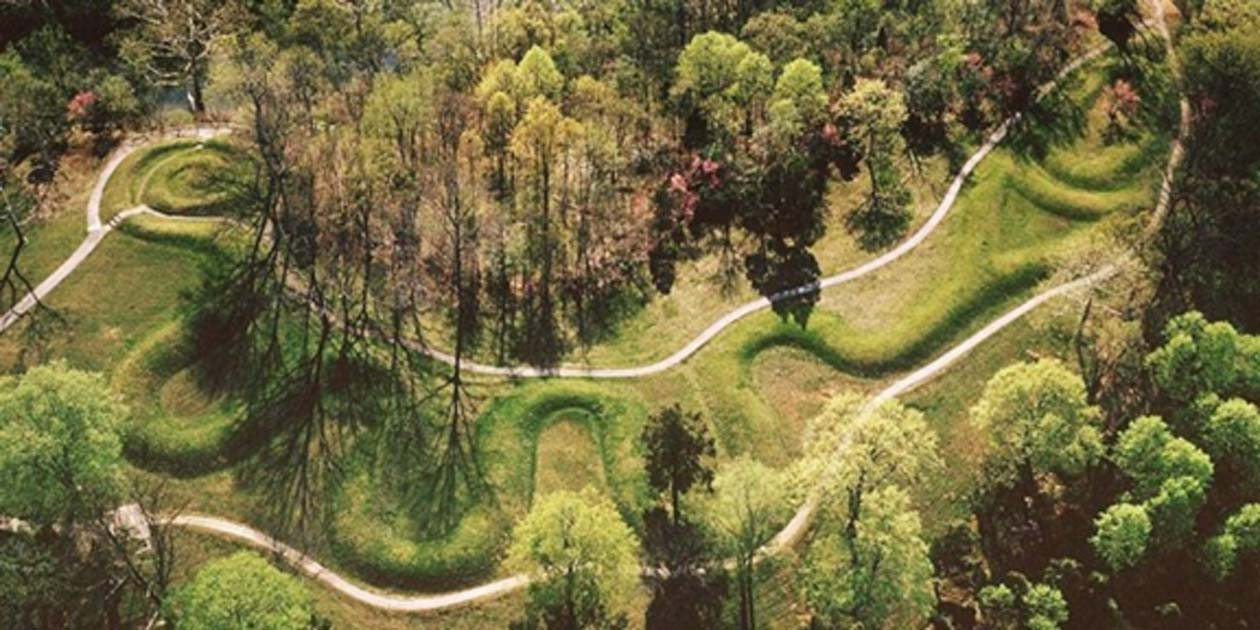
Great Serpent Mound
Mississippian
1070 CE
Earthwork/effigy mound
sacred space, likely associated with supernatural power
intentional decision with material and location (adjacent to a creek, which it follows)
Mississippians had a highly organized gov’t
No burials or artifact in the mound
The shape of the snake was significant: its shedding has been associated with supernaturalism
They also believed that the snake in the mound had always been there, and that the mound helped to emerge it
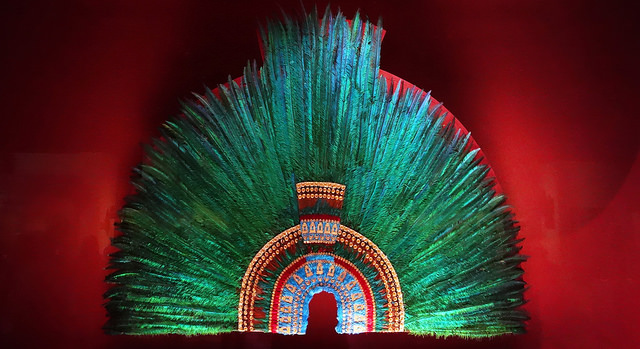
Ruler’s Feather Headdress
Mexica (Aztec)
1428-1520 CE
Gold and feathers (quetzal and cotinga)
Came from male quetzals, which indicates long distance trade
Costume was incredibly important to the Aztecs; this piece was meant to be seen in the movement of the ruler
Luxury products were demanded from cities the Aztecs conquered
Spanish conquistadores were so impressed by this that they allowed these to continue to be produced after the conquest.
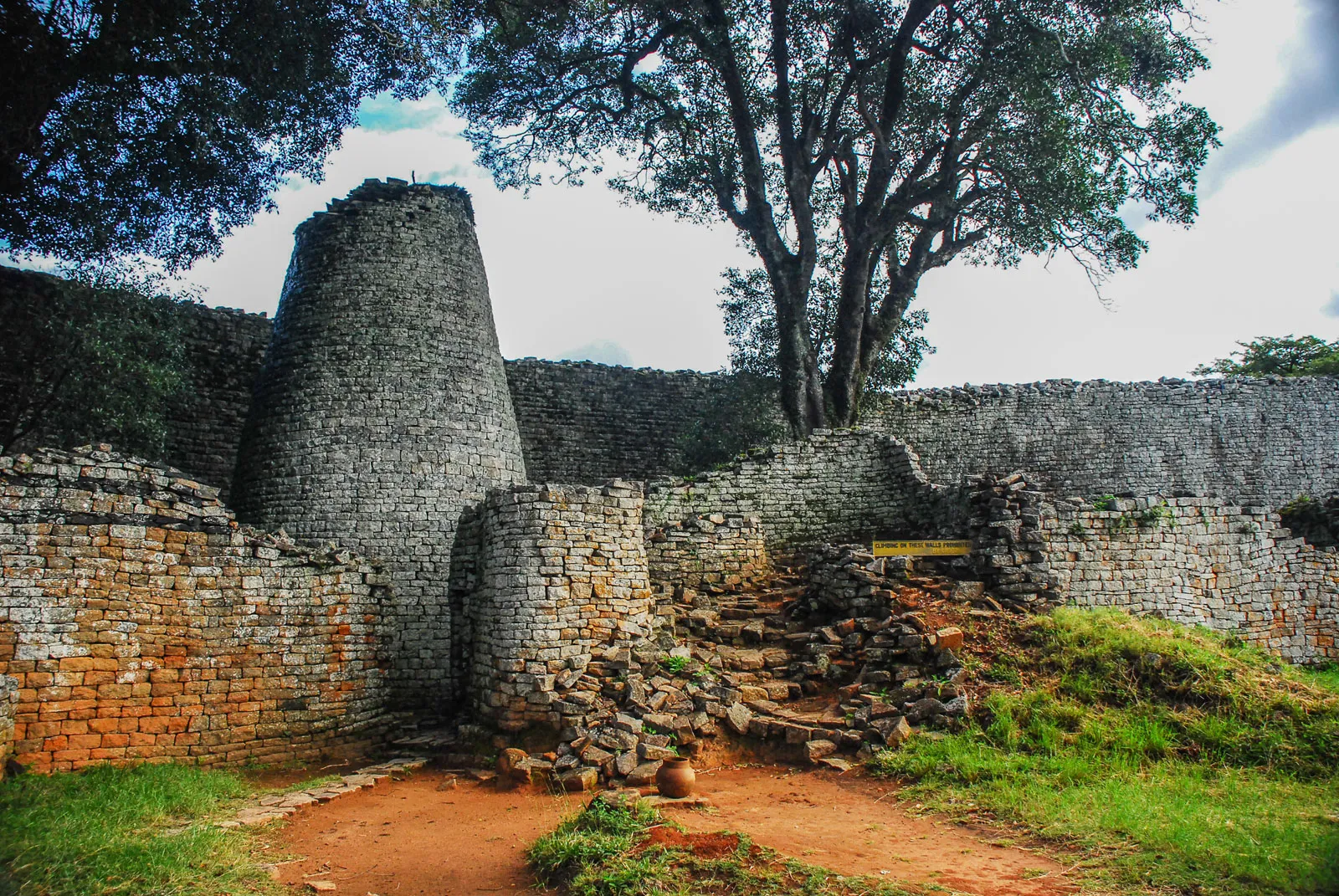
Great Zimbabwe
Shona peoples
1000-1400CE
Coursed granite blocks
Elevated surfaces for sleeping/sitting
“Dramatic architecture”
Held about 250 royal houses
Symbol of political and economic power (trade network)
Split into 3 parts: Hill Ruins and Great Enclosure possibly for elite or ritual purposes, while Valley Ruins were where people lived
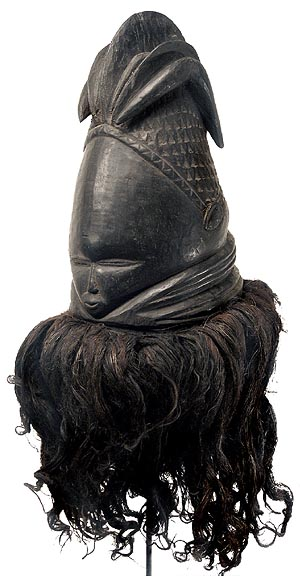
Bundu Mask
19th–20th century CE
Sande Society, Mende peoples (Sierra Leone and Liberia)
Wood, cloth, fiber
Used in girls’ initiation rites
Only African mask worn by women
Idealized female beauty and moral virtue (high forehead for intelligence, pursed lips for wise speech)
Represents female water spirit and patron deity Sowo → the masks and dancers are said to become her at some points in the ceremony

Templo Mayor
1375–1520 CE
Mexica (Aztec)
Stone, volcanic stone, stucco
Twin temples dedicated to Huitzilopochtli (war/sun) and Tlaloc (rain)
Center of Tenochtitlán, reflects Aztec cosmology (axis mundli
Site of sacrifices and rituals — reenacting of Huitzilpotchli’s victory
Rainy season, sun sets behind Tlaloc, and behind Huitzilpotchli during dry season
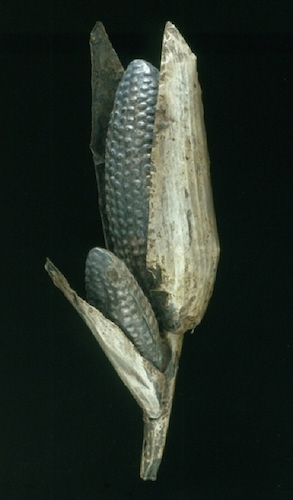
Maize Cobs
c. 1440–1533 CE
Inka
Sheet metal/repoussé, gold and silver alloys
Idealized naturalism — Inca visual expression, as opposed to geometrical and abstract shapes from Andean culture
Symbol of agricultural abundance and ritual offerings
Part of garden of life-size/miniature ritual objects in Qorikancha
Likely taken as spoils after defeat of Inka in 1530s
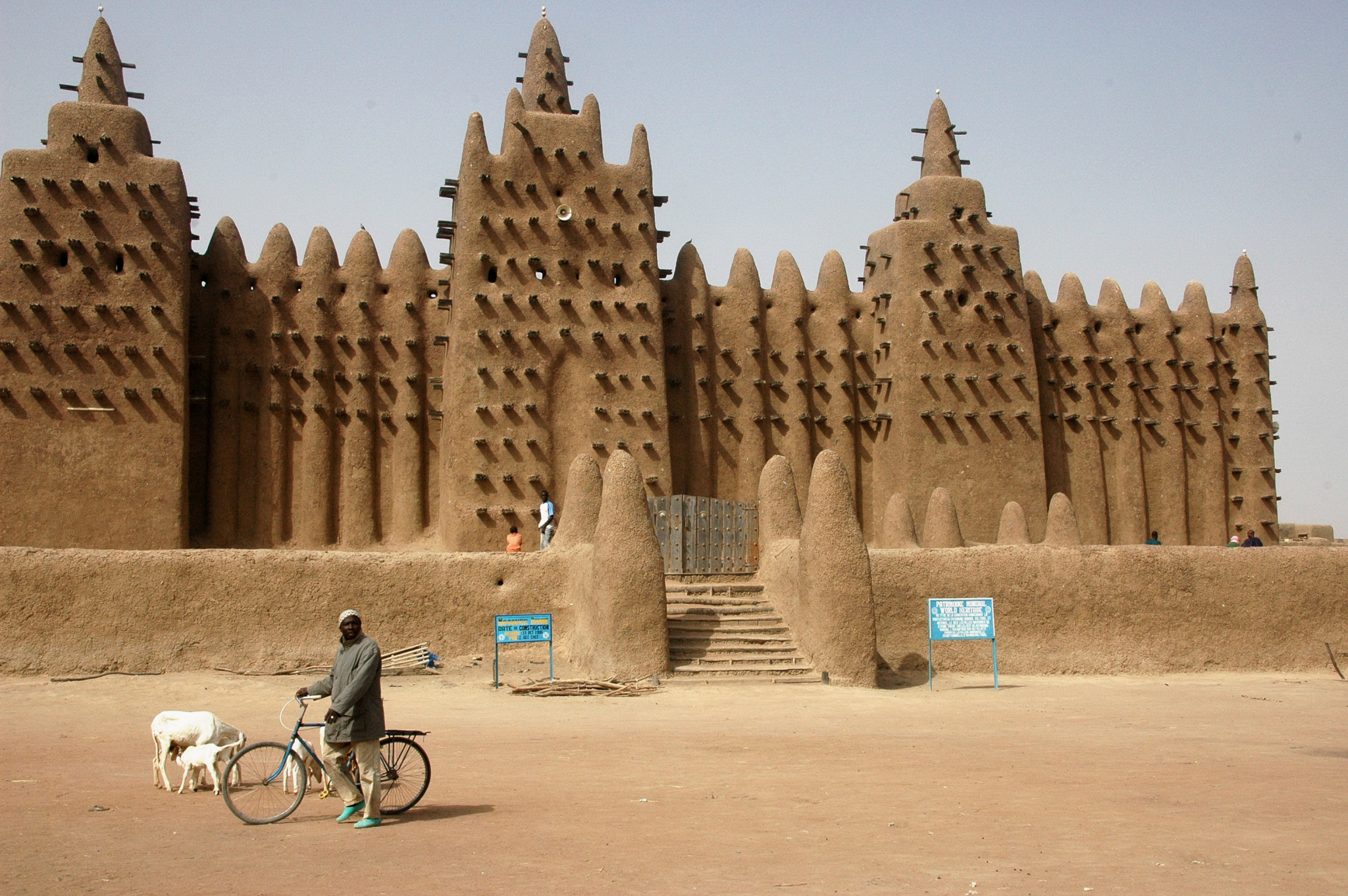
Great Mosque of Djenne
c. 1200 CE (rebuilt 1906–1907)
Mali
Mudbrick
Largest mudbrick structure in the world; elevated on a platform, mainly for water damage preventing
Community re-plasters annually (Crepissage); represents devotion to God and community
Center of Islamic learning and trade to indicate economic health
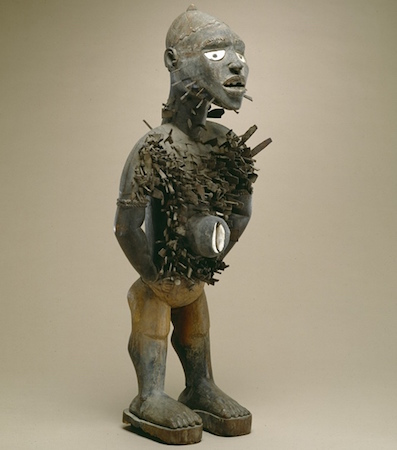
Nikisi n’kondi (Power Figure)
c. late 19th century CE
Kongo peoples (DRC)
Wood and metal
Spiritual figure activated through rituals
Nails represent oaths, healing, or justice -→ if you recant on your promise, the deity will come after you
Filled with believed to be apotropaic substances - if they are removed, the deity is as well

Yaxchilan
725 CE
Maya
Limestone (structure and reliefs)
Likely a burial site for Lady Xoc and her husband
Known for lintels depicting rituals and royal lineage
Structure 23 shows Lady Xoc performing bloodletting to justify her husband’s rule
Demonstrates Maya hieroglyphic writing and dynastic propaganda
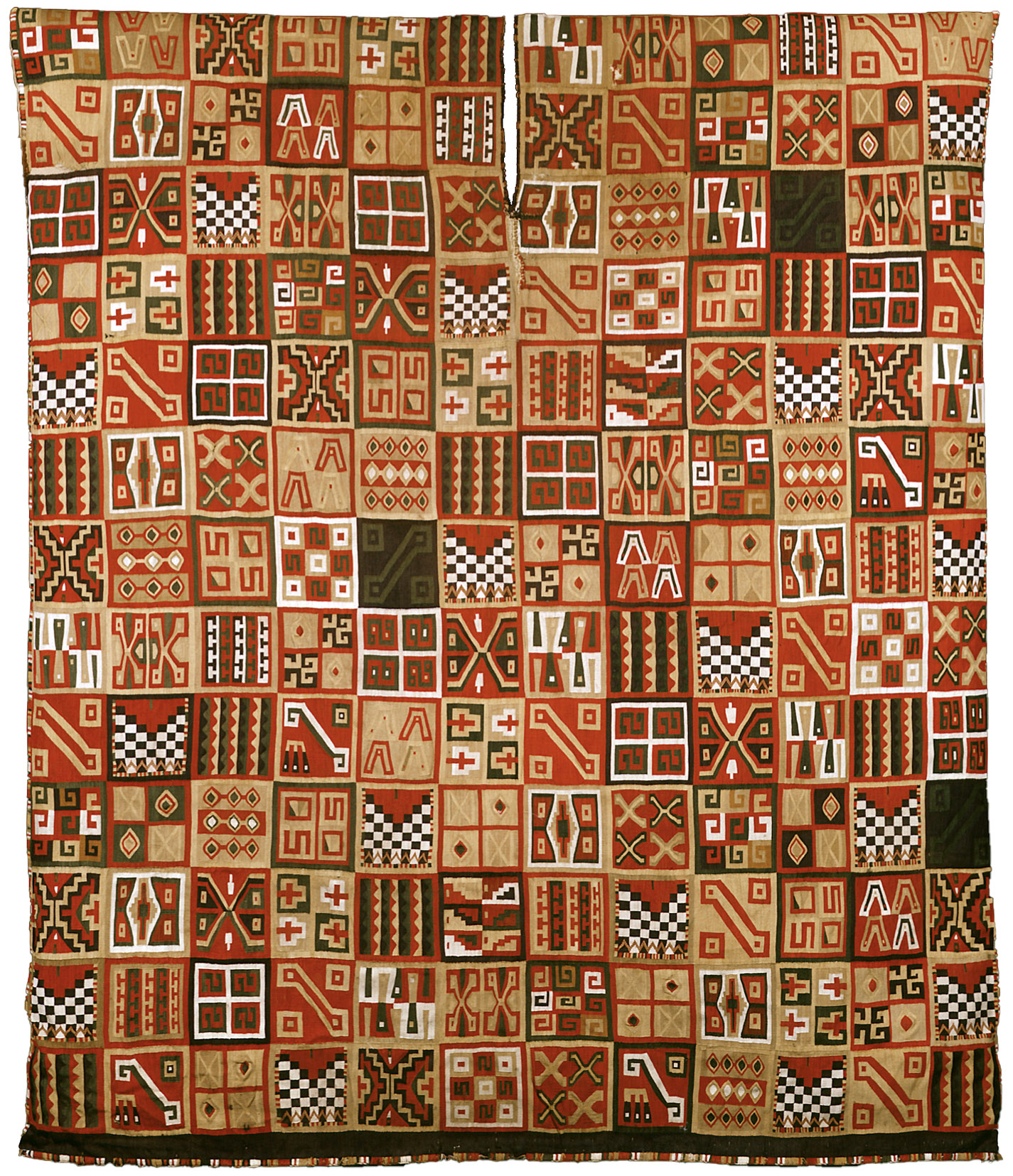
All-T’oqapu tunic
1450–1540 CE
Inka
Camelid fiber and cotton
Worn by elite, possibly emperor or sacrificed to sun god Inti
Weaving held spiritual and political importance, so the tunic was woven in one piece, as cutting the loom was thought to destroy spirit existence
Cochineal red and indigo blue dye were indicative of high status (camellid fibers were easier to dye)
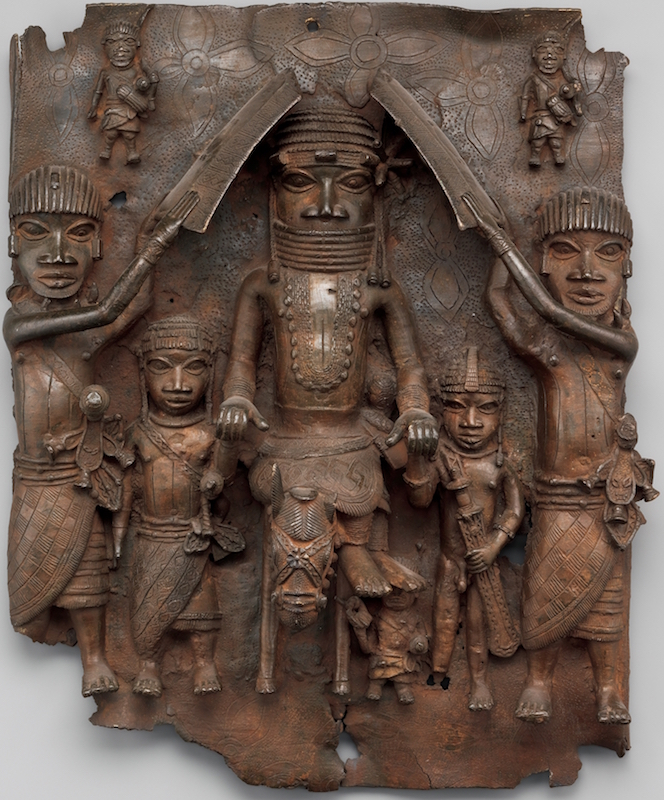
Wall Plaque, Oba’s palace
16th century CE
Edo peoples, Benin (Nigeria)
Cast brass
Depicts Oba (king) and court officials, the Oba being significantly larger (hierarchy of scale)
Lost-wax casting tradition, which used immense amounts of brass from Portuguese traders
Showed wealth and divine kingship of the Oba
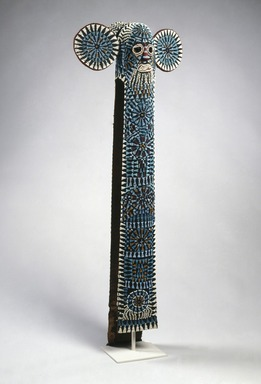
Aka Elephant Mask
19th–20th century CE
Bamileke (Cameroon, western grassfields region)
Wood, woven raffia, cloth, beads
Worn by members of Kuosi society, the highest society under nobility/royalty → a means to intimidate the lower classes
Elephant symbolizes power and wealth, and is considered to be the alter ego of the king
Danced at royal court celebrations
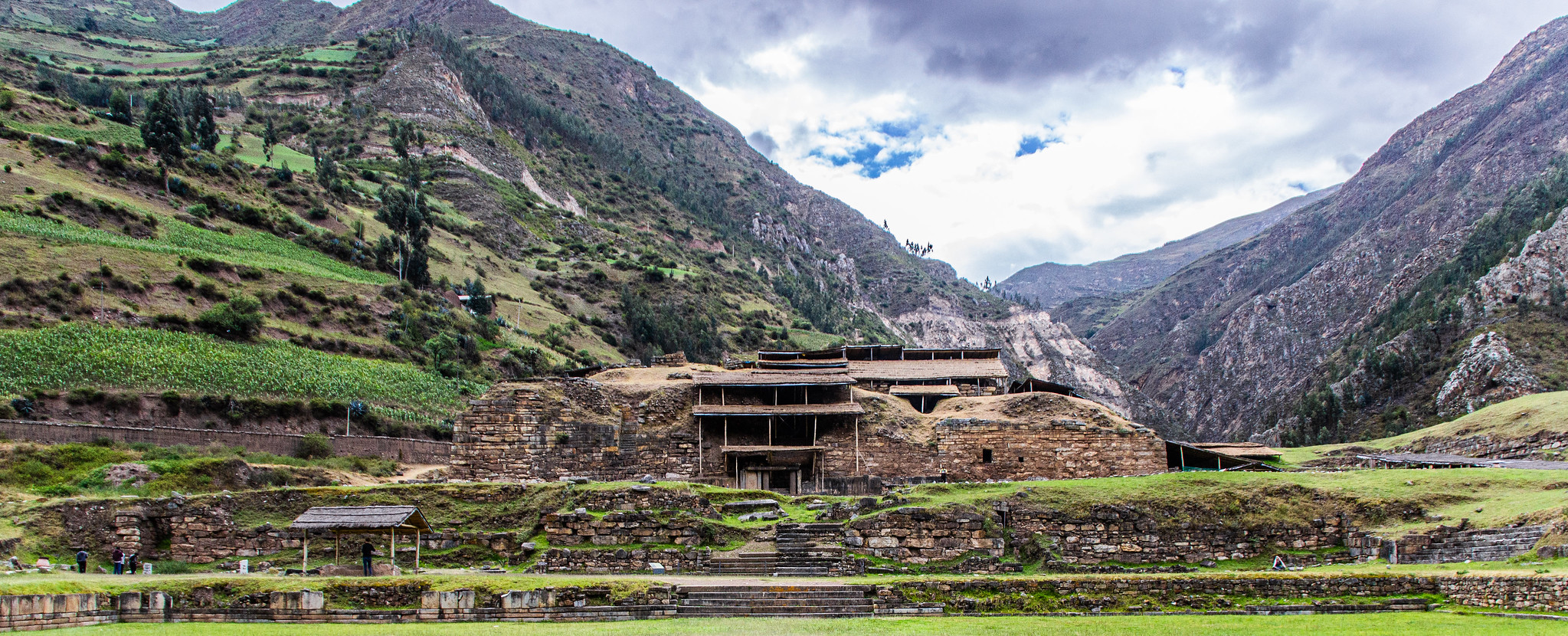
Chauvín de Huántar
900–200 BCE
Chavín (Peru)
Stone (architecture), granite (Lanzón and reliefs), gold alloy (jewelry)
Religious and ceremonial center of Chavín culture
Iconography combines human and jaguar imagery, which represents power
Pilgrimage site that helped unify people culturally; offering came from faraway places
Long maze like corridors that controlled access to sacred places and put visitors in a trance-like state

Bandolier Bag
c. 1850 CE
Lenape (Eastern Woodlands)
Beadwork on leather
Inspired by European ammunition bags, though these weren’t nearly as durable
Made by women, ceremonial regalia worn by men
Beadwork reflects cultural resilience and exchange
Pre-colonialism, decorative work was done by porcupine quills
Post-contact, glass beads from Venice were used
Embroidery was learned by Canadian nuns
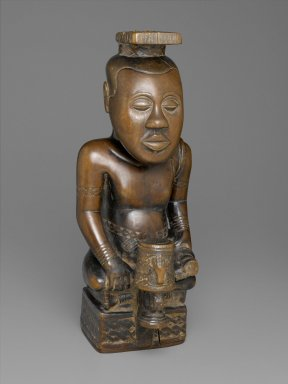
Ndop (Portrait Figure)
760–1780 CE
Kuba peoples (Democratic Republic of Congo)
Wood
Idealized portrait of king (not literal likeness)
Acts as spiritual double of ruler
All placed together, so one could derive the royal lineage
All have the same seated pose, ornamentation, stoic expressions, and headdresses and blades
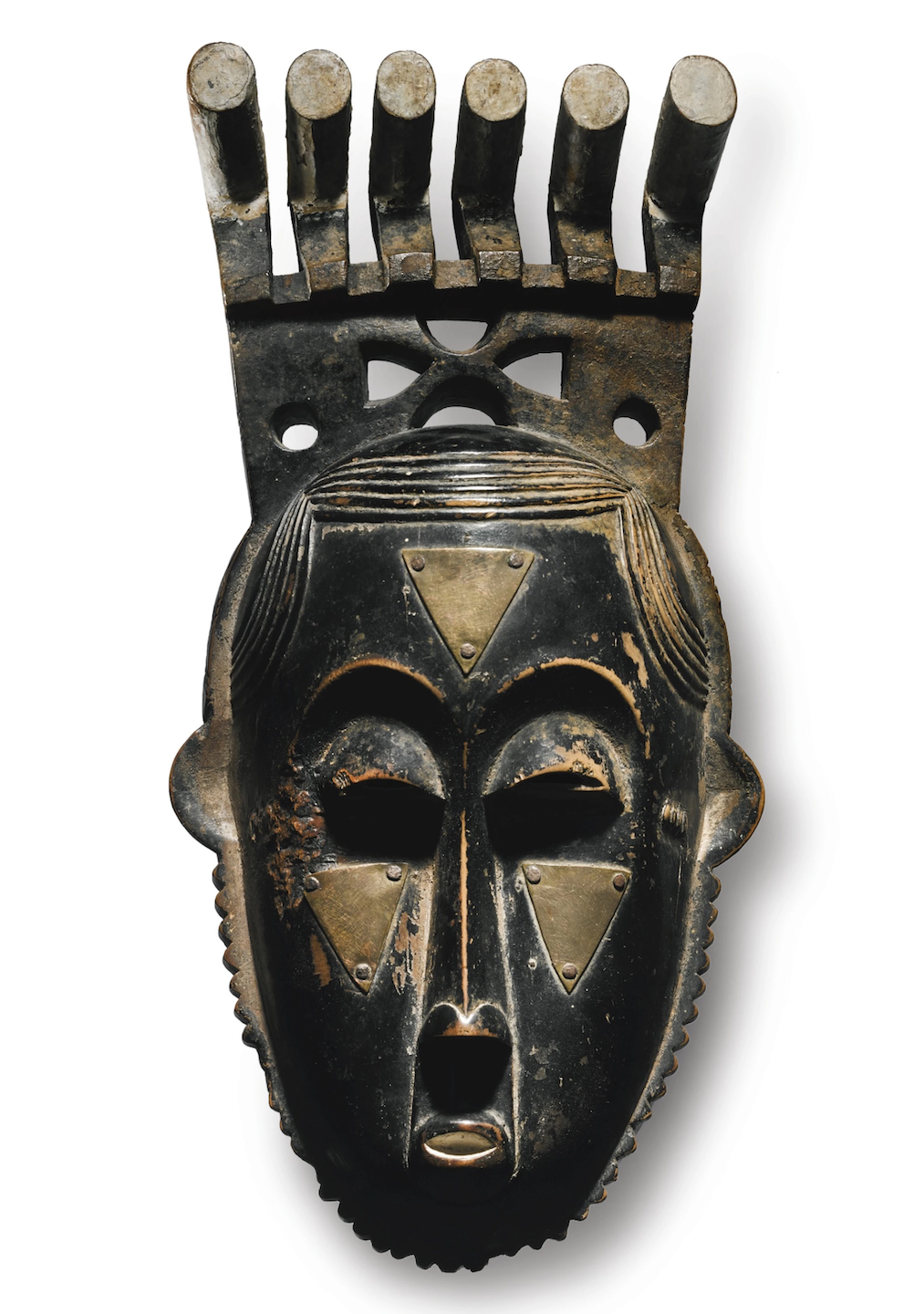
Mblo portrait mask
Early 20th century CE
Baule peoples (Côte d’Ivoire)
Wood, pigment, metal
Worn in dance performances (always by a man) honoring individuals (women)
Idealized features, reflects values of beauty and virtue
Performance includes music, dance, costume; the women’s mannerisms are studied and imitated during the performance
Said to be the spiritual double of a woman, so it can’t be commissioned without her permission
It can’t be seen without her or one of her close relatives being with it.

Transformation Mask
Late 19th century
Kwakwaka’wakw (Northwest Coast of Canada)
Wood, paint, string
Meant to be seen in movement; opens during performance to reveal second face (conceals and reveals identity)
Used in potlatch ceremonies
Represents spiritual transformation and clan identity (the belief that birds/fish/humans/animals differ only in skin + can transform into one another)
The Seattle Seahawks logo is a transformation mask

Black-on-Black vessel
c. mid-20th century
Puebloan, San Ildefonso, New Mexico; Maria Martínez and Julian Martínez
Blackware ceramic
Revitalized ancient Pueblo pottery techniques
Matte and glossy finish creates subtle decoration
Elevated Indigenous craft to fine art status

Sika dwa Kofi (Golden Stool of Ashanti)
c. 1700 CE
Ashanti peoples (South Central Ghana)
Gold over wood and cast-gold attachments
Symbol of Ashanti nation and soul of the people
Never sat upon, only by the stool itself
Represents unity and authority
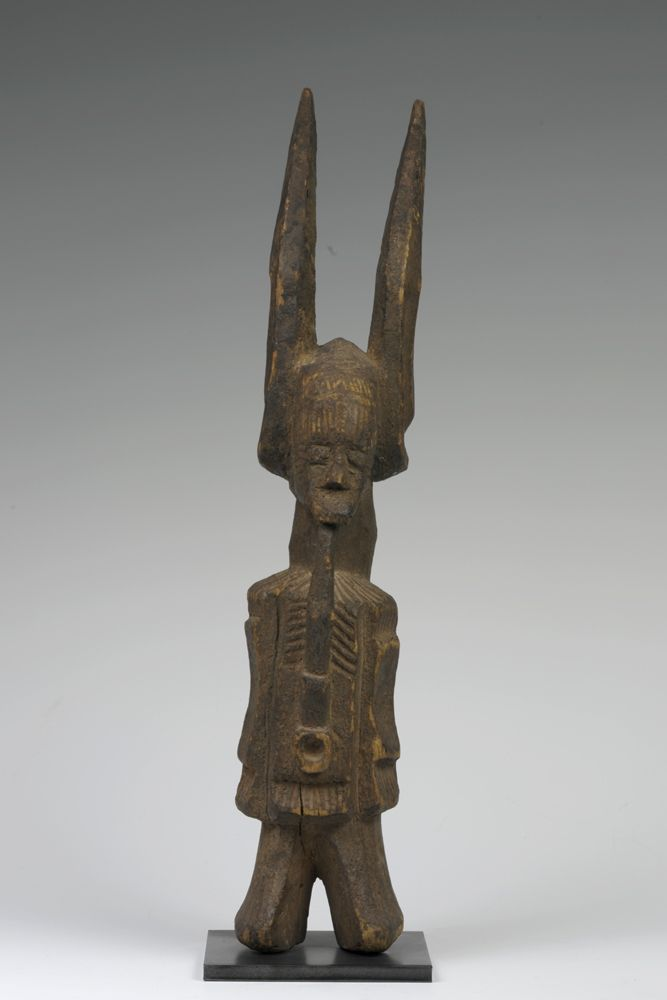
Ikenga (shrine figure)
c. 19th–20th century CE
Igbo peoples (Nigeria)
Wood
Personal shrine representing a man’s power and success
Horns symbolize strength and determination
Ritual offerings and prayers made to it

Mesa Verde Cliff Dwellings
c. 450–1300 CE
Ancestral Puebloan (Anasazi)
Sandstone, mortar, plaster
Built into cliffs for protection and insulation, and dwellings were very much elevated
Contained kivas (ceremonial spaces)
Shows community planning and adaptation to environment
Abandoned due to drought/migration
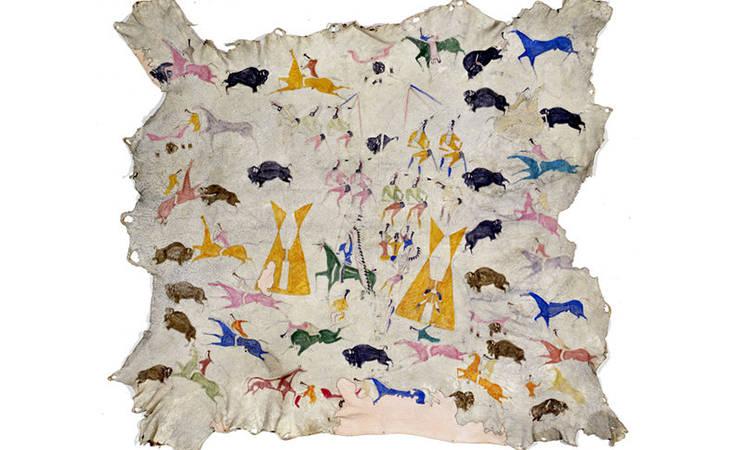
Painted Elk hide
c. 1890–1900 CE
Eastern Shoshone (Wind River Reservation, Wyoming); attributed to Cotsiogo (Cadzi Cody)
Painted elk hide
Depicts Sun Dance and buffalo hunt
Storytelling about the past (cultural preservation and pandering to collectors)
Paints were commercialized, so more vibrant colors were used than traditionally
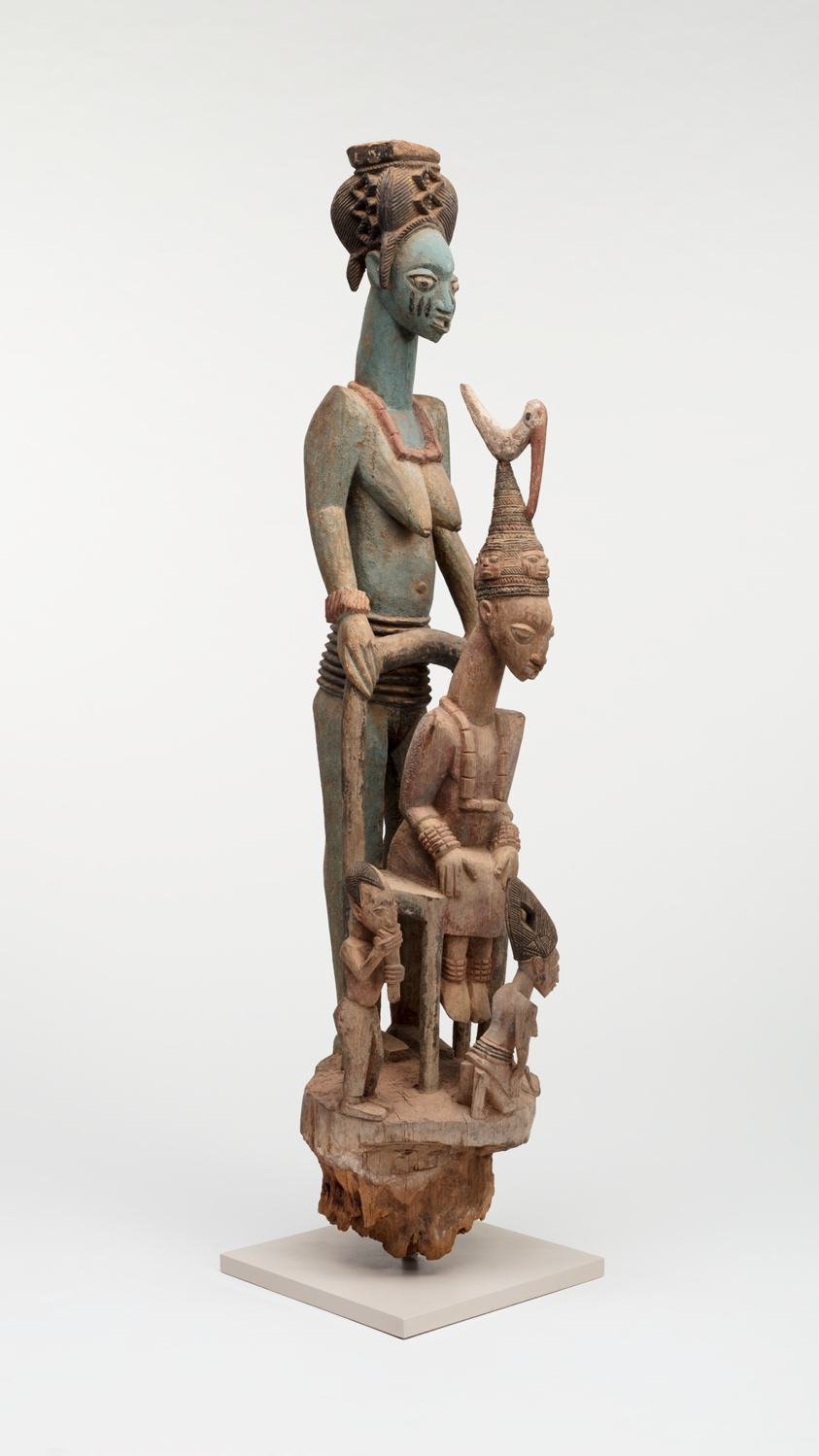
Veranda post
c. 1910–1938 CE
Yoruba peoples (Nigeria) → Olowe of Ise
Wood and pigment
Functions as an architectural support post for palace
Senior wife’s placement indicates close, supporting relationship between her and king
Her eyes are alert and protective to ward off evil
Trickster god Esu announces the presence of the kind
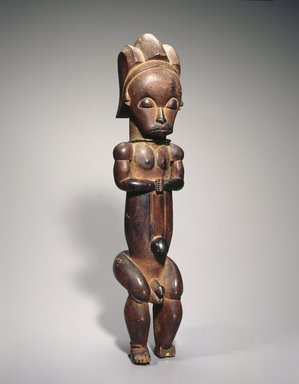
Byeri (reliquary figure)
c. 19th–20th century CE
Culture: Fang peoples (Cameroon)
Medium: Wood
Guarded ancestral relics in cylindrical containers
Combines naturalism and abstraction
Ensured ancestral protection and continuity
During youth initiation rituals, they would be removed from the containers and set at the youth’s feet.

City of Cusco
1440 CE (Inca capital established earlier)
Inka
Andesite (stone)
Laid out in shape of a puma (symbolic of power in Inka culture)
Sits at 11,200 ft (extraordinary elevation)
Qorikancha temple was spiritual and physical center (axis mundli)
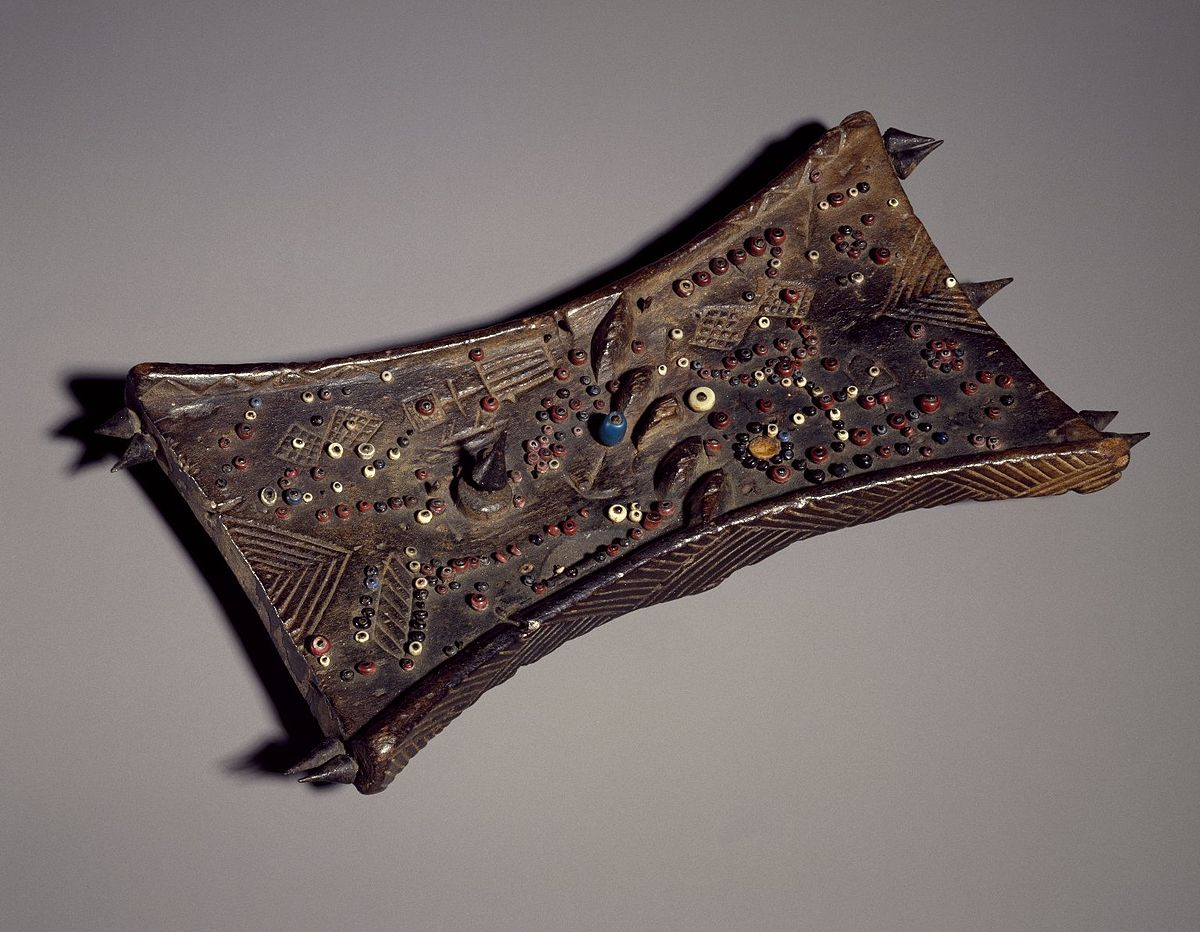
Lukasa
. 19th–20th century CE
Luba peoples (DRC)
Wood, beads, metal
Used by trained members to recount history and genealogy
Tactile reading of beads and shells
Encoded political and cultural knowledge

Pwo Mask
Late 19th–early 20th century CE
Chokwe peoples (DRC)
Wood, fiber, pigment, metal
Honors female ancestors
Worn by male dancers in initiation rituals
Symbolizes fertility and womanhood with Pwo being young, beautiful, and ready for marriage
Paired with Cihongo, the founding father → when danced together, they bring fertility and prosperity for all time
Identity is covered so “Pwo” can inhabit the body and teach the boys founding stories and to treasure women
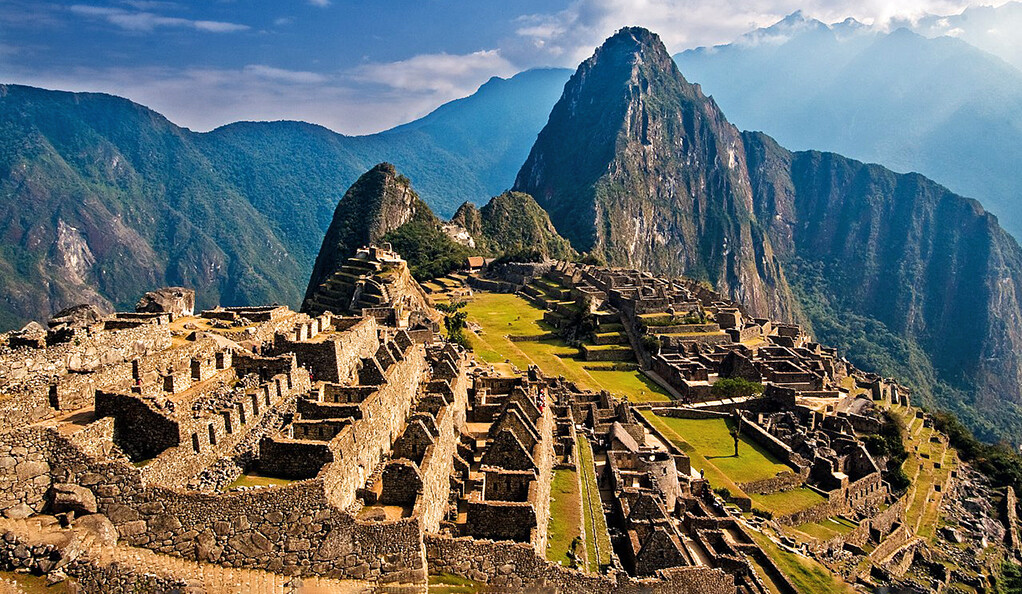
City of Machu Picchu
c. 1450–1540 CE
Inka
Granite (architectural complex)
Royal estate of first Inka emperor
Lower elevation, but meant to be a place of entertainment, religious ceremony, and administering the affairs of the kingdom
Stones for the complex were laboriously shaped with tools, and fit together meticulously
Lower status buildings did not have the meticulously shaped stones of high Inka society + had rougher construction